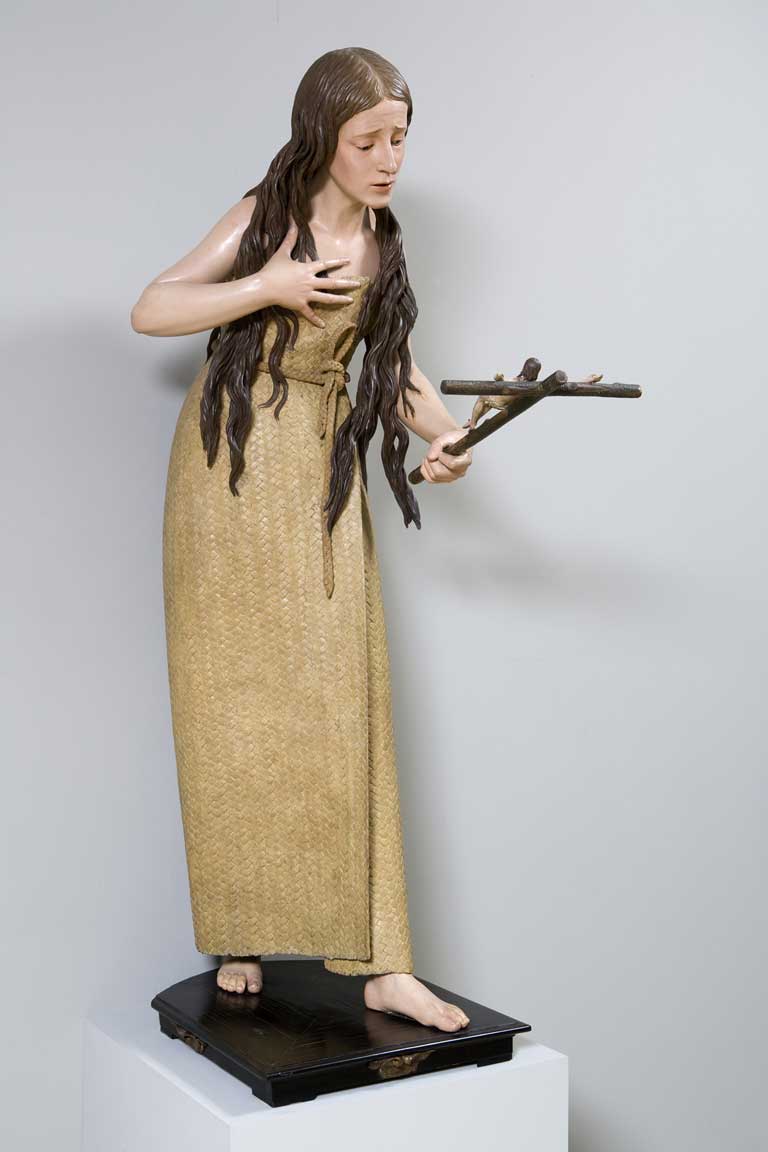Great Works: Mary Magdalene Meditating on the Crucifixion, 1664, By Pedro de Mena
Museo Nacional del Prado, Madrid

Your support helps us to tell the story
This election is still a dead heat, according to most polls. In a fight with such wafer-thin margins, we need reporters on the ground talking to the people Trump and Harris are courting. Your support allows us to keep sending journalists to the story.
The Independent is trusted by 27 million Americans from across the entire political spectrum every month. Unlike many other quality news outlets, we choose not to lock you out of our reporting and analysis with paywalls. But quality journalism must still be paid for.
Help us keep bring these critical stories to light. Your support makes all the difference.
Art itself is a kind of prestidigitation, illusionism, magic. It cajoles us into giving credence to the reality of pretence. So when art also engages with religious themes, the plot seems to thicken.
There is the illusionism of art – and then there are the various additional levels of illusionism that seem to be encouraged, if not demanded, by religious belief. How do the two marry? How does art deal with these issues? In the case of Fra Angelico's great Annunciation in Florence, the two beings who face each other – Mary and the Angel of the Annunciation – look uncannily alike.
In fact, they almost seem to be mirroring each other. Their hair styles are very similar. They cross their arms in very similar ways, appearing to do a kind of gentle obeisance to each other. But they are not entirely alike. There is one very important and intrusive visual detail that separates them absolutely. The Angel sports gorgeous wings. That detail, in the context of such inwardness, such a degree of calm acceptance, seems immensely stagey. Wings aside, this is not an encounter that induces fear – unlike, say, the celebrated Annunciation by the Venetian painter Lorenzo Lotto, where the woman flees in terror from the angel.
Here on this page is another way of selling the idea of religious belief to the credulous onlooker. It involves the shock of what we have in recent years come to call hyper-realism, which was a very fashionable tactic in Spain during the 17th century. Hyper-realism? But does not that remind us of the astonishing achievements of Ron Mueck? All that painstaking effort to make the flesh of the sculpted object look so much like our own that we could almost be persuaded into believing that it really is ours? All this seemed so shockingly new when Mueck first came on the scene with Dead Dad 15 years ago.
It was all old hat, of course. In the case of Pedro de Mena, the year was 1664. This sculpted form was made precisely in order to be an object of intense, awe-struck devotion. The sheer, ghoulish drama of its physical presence almost strikes terror in the heart, even today. It seems to maintain a near-perfect balance of the day-to-day worldly reality of the moment in which it was made, and the near timeless otherworldliness of what it represents. The fact that it is so completely of-this-world (even as it purports to be present in some other, much more exalted space altogether), makes it even more affecting. The way in which Mary Magdalene is making that slight bow forwards, a bow both of heartfelt homage and curiosity, restraining her hair against her bosom as she does so, and dressed in a skirt that seems to be made from neatly woven rushes, brings her to life in front of us. She could be anyone's unusually pious daughter or niece, about to step forward, toes splayed, even as she also appears to be leaning slightly back against a wall in a corridor, casting a very lively shadow in this installation view.
There is something else rather curious about the scene here too, some slight trick of scale, and especially so when we see it an image on a page. How big is big? And how small is small? The fact that Christ too looks so lifelike as he lies there, almost relaxedly (legs drawn up? Surely not) in that horizontal position, having been lowered into it by her slowly sinking arm (that seems to be in the throes of sinking even lower even as we look at it), gives the illusion that he may be lying on a bed, and not suspended from a crucifix at all, and that he may even be of human size, with Mary Magdalene rising up above him, and looming over him, like a giant predator, relishing the possibility of this tasty morsel of a man. This is my body. Take. Eat.
The wilder shores of weirdness.
About the artist: Pedro de Mena (1628-1688)
Pedro de Mena, born the son of a sculptor in Grenada, was celebrated for his intensely realistic sculptors of religious subjects. Famous in his day and much in demand, he served as sculptor to Toledo Cathedral in 1663, though he failed in his efforts to be appointed court sculptor in Madrid. He became especially renowned for his lifelike, contemplative depictions of Christ as the Man of Sorrows and The Virgin of Sorrows. He made these works, single-handedly, again and again.
Join our commenting forum
Join thought-provoking conversations, follow other Independent readers and see their replies
Comments